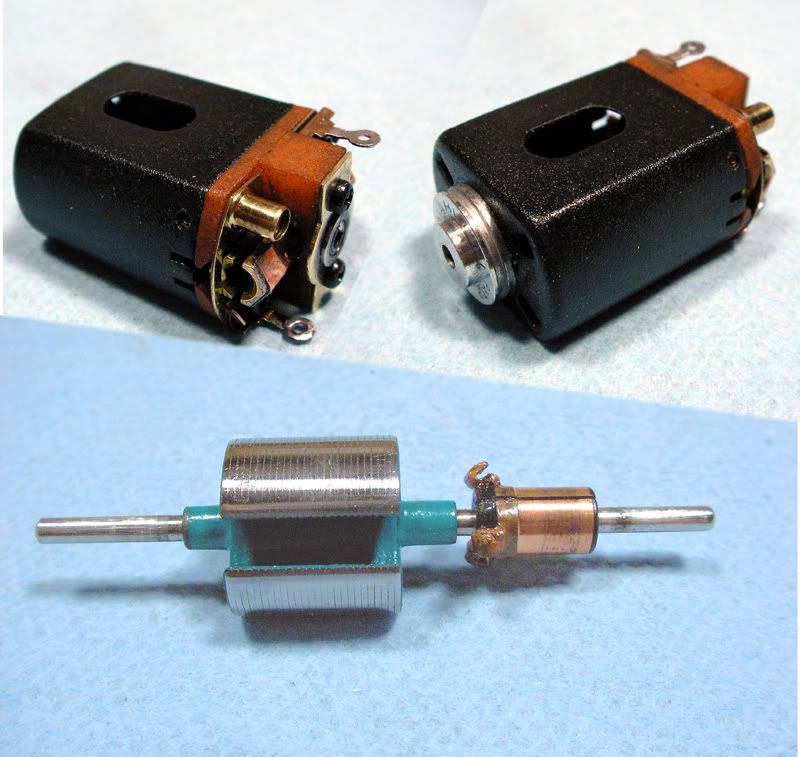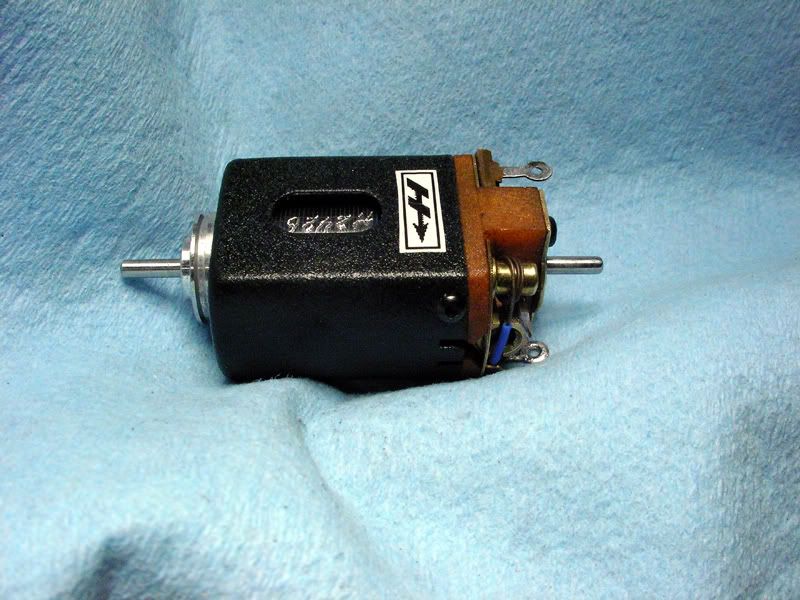
#1751

Posted 04 June 2010 - 08:31 AM
"We offer prompt service... no matter how long it takes!"
"We're not happy unless you're not happy"
"You want it when?"
#1752

Posted 04 June 2010 - 11:55 AM
In general the oilite in a Parma has about 2 hours of work to it before the the slop leads to replacement as an anglewinder, 3 hours in inline applications.
Fate
3/6/48-1/1/12
Requiescat in Pace
#1753

Posted 05 June 2010 - 03:20 PM
Speaking of the arm, the arm is chose is a different one from any I've seen before. It measured .525" stock (?) and just cleared the magnets, so I took it down to around .520". There won't be any shimming on this motor, that for sure! After the final polishing, it will probably come in around .519" or .518". The whole shebang is ready for winding, maybe tomorrow and Ernie...I'll take photos of the winding as it proceeds.

#1754

Posted 05 June 2010 - 04:20 PM
Steve King
#1755

Posted 05 June 2010 - 04:28 PM
and Ernie...I'll take photos of the winding as it proceeds
You're a scholar and a gentleman!! Thank you kindly!!
Ernie
#1756

Posted 05 June 2010 - 04:44 PM
I AM the man from Nantucket.
#1757

Posted 05 June 2010 - 05:12 PM
Orangepicker.
...THAT'S the name, thanks Slotbaker! I have another one around here too, that I just have to fashion a bearing strap for.
You're a scholar and a gentleman!! Thank you kindly!!
...I'm afraid I fall short on both counts Ernie, but thanks! and you're welcome
Hey John, what are you using to turn down the stack diameter?
Hi Andrew. I chuck the arm in a Dremel, and play it at slow speed against some sandpaper. To minimize the effect of any runout in the Dremel, I loosen the chuck, rotate the arm and do a bit more. The I flip the arm and chuck the other end doing the same. #320 paper leaves a good finish and #220 cuts faster. A quick hit with #600 after the arm is done makes it look almost like chrome. If I'm going to dye the arm, I don't go any finer than #220 because the dye goes on even and holds better.
-john
#1758

Posted 05 June 2010 - 06:31 PM
#1759

Posted 05 June 2010 - 07:43 PM
Nice work John i like the wrinkle finish on the can and that bearing plate is a great idea,
Thanks Robert, these are really nice motors for sure. The bearing plate is cool and I've installed them on a few other motors, but they are a pain if you're going to mount the motor endbell drive. You'd have to remove the screws and reinstall them (or slightly onger ones) through the chassis motor bracket. This motor will have enough shaft to go either can or endbell drive and with the bearing carrier that can accept a C-ring or Circlip, it wouldn't be a problem to mount it can drive on an inline chassis. Of course, the motor could be mounted with no bracket by soldering it in.
the paint on the arm looks pretty clean are you going to insulate it with furnace cement or leave it as is
The insulation on this arm is undamaged so I'll use it as is. In order to use the furnace cement, I'd have to strip the insulation because it sticks best to bare metal.
-john
#1760

Posted 06 June 2010 - 02:31 PM
Here's the arm after prepping loaded into my crank, set up with some #26 wire. To start, I have the wire wrapped around the top of the com and it's ready to wind clockwise (as you face the arm pole).

First layer is important...get 'em on there straight and neat. Tension (I use my thumb and forefinger to put "drag" on the wire as I turn the crank) is important too...not too much, but definitely enough.

First pole is all done. Coming over the top of the arm for the last turn, I hook the wire underneath and over the next com tab. After pulling the wire around the com tab, you will have a clear picture of where top strip the wire since the wire will keep some of the bends after removing it temporarily. I scrape all around the area where the wire will contact the tab with a sharp X Acto #11 blade and then reseat it on the com tab.

Loosen the clamp and turn the arm to expose the next pole for winding. Away we go....

Same thing as the previous pole, now pole #2 is done. Again, after wrapping the wire around the com tabe, I remove it temporarily to scrape away the insulation where it will contact the tab using the bends as a guide as to where to scrape.

Last pole is done and it's time to scrape away the insulation from the first end of the wire and the last end of the wire so they can both cross over the first/last com tab.

Here's the arm with the insulation stripped from the last bits of wire (starting and ending) and ready for crimping and welding/brazing.

...next up, finishing the arm
-john
#1761

Posted 06 June 2010 - 02:44 PM
Tabs are crimped, com connections are welded and I cleaned-off the tabs as well to remove any burned gunk left on there so the epoxy will have a nice clean surface to grab onto.

Arm is tied up with kevlar thread and ready for some Duralco 4461.

Here's the arm all covered with epoxy. I went heavier than I normally would for the pictures so it was clearly visible. Not the best thing for performance, but it won't really hurt either. Anyway, time to pop it into the eazy bake over to speed cure the epoxy.

Fresh out of the oven and baked to a crispy golden brown

Time to balance the arm, so onto my RGEO balance block (thanks Rick). Little-by-little until there's no obviously heavy pole.

Arn is balanced abnd ready to have the com trued/cut and be engraved with the wind and get a quick final polish.

...and as they say in the land of frog's legs, Bordeaux and crusty bread..."et voila!"

...now I just have to install the arm in it's fresh setup. That will involve just arm spacers and truing the com and tail spacer. The magnets are already installed to center this arm in the field and I checked the brush tubes to be sure that brushes will not hang up in them (a slight bit with a miniature file takes care of that). Can and endbell are already drilled for retainer screws so the last bit is easy.
-john
PS: the arm reads solidly down in the .2 ohm range
#1762

Posted 06 June 2010 - 03:01 PM
Great tutorial very informative this should be a big help for many people getting into rewinding, i have tried that hand crank but it didn't work for me i find it a bit awkward to use i just use a pin vice in a small table top bench vice probably not the recommended way but so far it does seam to work.
#1763

Posted 06 June 2010 - 04:53 PM
That is insane!!!! I can't wait till i get my wire this week. If my arms come out half as good as that I'll be thrilled!
You're incredible dude!
I AM the man from Nantucket.
#1764

Posted 06 June 2010 - 06:30 PM
i just use a pin vice in a small table top bench vice probably not the recommended way but so far it does seam to work.
Hey, whatever works is the "right" way to do it Robert. Your work sure looks fine to me so..."don't mess with success"!
If my arms come out half as good as that I'll be thrilled!
I bet they'll be splendid in no time Andrew, and I get the biggest kick from seeing others getting into winding. There is a small group here Pablo, myself, Doug Azary, Robert, yourself and a couple others I'm forgetting that have gotten going with winding and I think that's aces. You don't need rare old motors or very expensive equipment, just a little interest and determination. It's a real thrill when you spin up one of your own for the first time!
Back on this Champion Orange Picker. I got the motor assembled and it sounds...impressive

I think this one might go into my private collection as it's kinda unique and I'm getting attached to it...or I might donate it to the LIHSCD (Long Island Historical Slot Car Depository)
-john
- MarcusPHagen likes this
#1765

Posted 06 June 2010 - 06:48 PM
It's a real thrill when you spin up one of your own for the first time!
You can say that again ! Wheeeeeeee !
Might I add, one does NOT need a bunch of expensive equipment/tools to do this.
I use a Weller gun to solder comm tabs, Devcon 2 part Epoxy from Home Depot, an electric drill to polish lams, and a magnetic balancer.
John started this thread similarly, but has, slowly but surely, gravitated towards more sophisticated methods
John has taught me a lot just by reading this thread......little tips like using a coat of epoxy instead of insulation washers, etc.
My personal favorite thrill is disproving traditional winding theories
Paul Wolcott
#1766

Posted 06 June 2010 - 06:55 PM
Rick Thigpen
Check out Steve Okeefe's great web site at its new home here at Slotblog:
The Independent Scratchbuilder
There's much more to come...
#1767

Posted 06 June 2010 - 08:07 PM
I took note that you wound the wire around each pole continuously, wrapped it around the tab and continued to the next pole, yet I remember it being mentioned somewhere back some pages (I don't' remember who mentioned it), to cut the wires the same length for each pole so the number of winds per pole would be consistent- I'm not quite comprehending please? When would you cut individual strands of wire and when would you not?
Thanks for the tech writeup "Professor John"!!! Awesome!!!
Ernie
#1768

Posted 06 June 2010 - 09:13 PM
John started this thread similarly, but has, slowly but surely, gravitated towards more sophisticated methods
John, am I wrong ?
Well that's sort of true Pablo. I have tried to do what I could within reason to make the arms better. I still use razor blades to balance the arms when dynamic balancing is more accurate. I have gone to brazing the com tabs on most of the arms (except for Tradeship coms), but I use a car starter and the carbon electrode from a C cell zinc/carbon battery. The tooling is pretty crude over here by anyone's standard...but the one thing I do use that's expensive is the Duralco 4461 epoxy and it's soooo much better.
Maybe my next rewind won't look like I used my feet
I've done that with some of your builds Rick...and my chassis still look the same
I remember it being mentioned somewhere back some pages (I don't' remember who mentioned it), to cut the wires the same length for each pole so the number of winds per pole would be consistent- I'm not quite comprehending please? When would you cut individual strands of wire and when would you not?
I've never done it that way Ernie and got used to doing it with one continuous piece of wire when I was young. I think the Mabuchis and most factory arms are/were wound this way...one length of wire), I know the SCX RX 42 arms are since I've taken a bunch of those apart. I try and duplicate the patterns on each pole instead of focusing on the length of wire. The reasoning being that the last turn of each pole must always end at the com. If you try to use the same length of wire on each pole but don't have consistent patterns, you could very well wind up at the bottom of the stack instead of the com and have to cut off a half turn of wire. On a thin gauge arm, a half turn won't make a difference...on a big wire arm like those vintage beauties you see Rick stick in his motors, a half turn is a lot. I've screwed around a little with this and found that the length of wire is VERY consistent from pole to pole when you wind this way. A side benefit is that only the first/last pole has "broken" wire on it and I make sure that the kevlar is especially solid on that pole to help add a little insurance. On the other two com tabs, there's an unbroken loop of wire going around the tab...very strong. Still, it's just as "correct" to use three equal lengths of wire...whatever works!
The biggest help in all this isn't any one technique I think. Being careful about prepping the arm to avoid problems is a biggie and having good quality/consistent materials to work with is a BIG help. I saw here that Bill Bugenis is thinking of doing .007" lam arm blanks, judging by the arms and coms of his I tried...THAT would be major for rewinders. The quality and consistency from arm to arm was the best I'd seen next to the old Mura .007s, and those are like hen's teeth now.
-john
#1769

Posted 07 June 2010 - 12:17 PM
Probably MY fault. Back a while ago talking about winding, I said that using length was how I started because that is how I was taught!
What I found out was that when you wind enough, you get consistent enough that, given the "half turn" John mentions, you get regularly THAT close.
Mostly, I use length for known resistance and translate that to turns.
As for "looking machine wound"...the thing is that machines don't do that good a job. You have all seen factory motors that look like barb wire. The issue is that the wire isn't perfect in either diameter or strength. Thus, the machine has to be set for "worst case" as in the weakest possible point in the wire. By HAND, you can feel the subtle differences in stretch and constantly adjust the tension...meaning you end up more consistent and better looking than machine.
Thus the advantage of "Hand Wound" group 20s or whatever.
The machine follows a setting, the hand winder can SEE the right pattern.
Fate
3/6/48-1/1/12
Requiescat in Pace
#1770

Posted 07 June 2010 - 11:23 PM
A winding machine sounds like a lot better option, this is just how I used to do it (late 60's early 70's). PS and I blew the crap out of comutators tring to weld tabs using a gutted battery for carbon core and car battery for amp source.
I am tempted to have another go.
#1771

Posted 07 June 2010 - 11:48 PM
My life fades, the vison dims. All that remains are memories... from The Road Warrior
#1772

Posted 08 June 2010 - 05:34 AM
A winding fixture or crank is a great way to do this stuff and really allows for a more consistent wind. However you do it, I think you would get great enjoyment out of having another go of it. Moderate winds (#30, #29...even #28) should be able to live without welding the coms and just using good higher temp silver solder...maybe 4 or 5% Ag if you can get it.
-john
#1773

Posted 08 June 2010 - 03:16 PM
Mike Boemker
#1774

Posted 08 June 2010 - 03:54 PM
Machine winds have come a long way, some are good enough to spark debates about whether they are hand wound or not
For sure!
The group 27 was not an easy arm to wind. I'm surprised a simpler to wind 26 arm didn't replace it
OK Mike, I'll bite
1)What is/was the G27 wind?
2)Who wants one?
3)What setup...modern C can?
4)Are you (whoever the hypothetical person is that might want one) willing to pay for the materials (say $20)?
5)Why were they difficult to wind?
-john
#1775

Posted 18 June 2010 - 10:17 AM
Slots-4-Ever
Brian McPherson
REM Raceway
"We didn't realize we were making memories, we just knew we were having FUN!"



 This topic is locked
This topic is locked













